
The Santuario della Madonna del Carmine also called Basilica di Maria Santissima Annunziata al Carmine, is a Roman Catholic minor basilica church and Marian sanctuary located on Piazza Carlo Alberto, in the town of Catania, Sicily.

The Santuario della Madonna del Carmine also called Basilica di Maria Santissima Annunziata al Carmine, is a Roman Catholic minor basilica church and Marian sanctuary located on Piazza Carlo Alberto, in the town of Catania, Sicily.
Putatively the site has seen multiple temples. The first church built here, titled Santa Lucia fuori le mura, was founded atop or among the ruins of a pagan temple dedicated to Jove. When this church was destroyed by an earthquake in 1075, a church dedicated to the Virgin of the Annunciation was built. Sometime in the 13th century, the Carmelite Fathers took possession and added a large adjacent convent. [1] The church was damaged severely during the 1693 Sicily earthquake and rebuilt in the present form by 1729. This church was elevated to minor basilica in 1988. The adjacent convent has been a barracks since the 19th-century.
Legend holds the church was once the first burial place for Saint Agatha, but in addition, the area during the Ancient Roman era served as a necropolis. Inside the adjacent convent are the stone remnants of an Ancient Roman tomb, which some authors had called the Tomb of Stesichorus. [2]
The exterior facade is notable for the giant order of columns, with a design attributed to Francesco Battaglia. Behind the niche with the statue of the Virgin of the Carmine at the superior tympanum are a series of 19th-century bells. A market place is held in the piazza outside the church.
The interior has a number of large altarpieces, and funereal monuments, and a wooden icon meant to depict St Agatha but modeled after an aristocratic donor to the church, Rosalia Petruso Grimaldi, who was murdered in 1784 by her jealous husband. [3] Among the various altarpieces are:

Caltagirone is an inland city and comune in the Metropolitan City of Catania, on the island of Sicily, Southern Italy, about 70 kilometres (43 mi) southwest of Catania.

Castello Ursino, also known as Castello Svevo di Catania, is a castle in Catania, Sicily, southern Italy. It was built in the 13th century as a royal castle of the Kingdom of Sicily, and is mostly known for its role in the Sicilian Vespers, when it became the seat of the Sicilian Parliament. The castle is in good condition today, and it is open to the public as a museum.

Santa Maria dei Miracoli and Santa Maria di Montesanto are two churches in Rome.

Santa Maria del Carmine is a church in Naples, Italy. It is at one end of Piazza Mercato, the centre of civic life in Naples for many centuries until it was cut off from the rest of the city by urban renewal in 1900. The church was founded in the 13th century by Carmelite friars driven from the Holy Land in the Crusades, presumably arriving in the Bay of Naples aboard Amalfitan ships. Some sources, however, place the original refugees from Mount Carmel as early as the eighth century. The church is still in use and the 75–metre bell tower is visible from a distance even amidst taller modern buildings.

Sant'Anna dei Lombardi,, and also known as Santa Maria di Monte Oliveto, is an ancient church and convent located in piazza Monteoliveto in central Naples, Italy. Across Monteoliveto street from the Fountain in the square is the Renaissance palace of Orsini di Gravina.

The Ancient Royal and Eminent Basilica Collegiate of Our Lady of the Alms, better known as Basilica della Colleggiata, is a church in Catania, Sicily, southern Italy. Finished in 1794, it is an example of Sicilian Baroque.

San Benedetto is a late-Baroque architecture, Roman Catholic church and former Benedictine monastery in the city Catania, Sicily, southern Italy. The church facade faces Via Crociferi, parallels across via San Benedetto the former-Jesuit church of San Francesco Borgia, and both are about a block south along Crociferi from the church and convent of San Giuliano. Entrance to church and monastery appear to be through Piazza Asmundo #9 near the apse of the church.
Francesco Nasini was an Italian painter of the Baroque period, active mainly in towns outside of Siena, Italy.

Santa Caterina d'Alessandria or Saint Catherine of Alexandria is a Roman Catholic church with a main facade on Piazza Bellini, and a lateral Western facade facing the elaborate Fontana Pretoria, in the historic quarter of Kalsa in the city of Palermo, region of Sicily, Italy. In front of the main facade, across the piazza Bellini, rise the older churches of San Cataldo and Santa Maria dell'Ammiraglio, while across Piazza Pretoria is the Theatine church of San Giuseppe and the entrance to the Quattro Canti. Refurbished over the centuries, the church retains elements and decorations from the Renaissance, Baroque, and late-Baroque (Rococo) eras. This church is distinct from the Oratorio di Santa Caterina found in the Olivella neighborhood.

San Michele e San Francesco is a renaissance-style, Roman Catholic parish church located in the Piazza SS Francesco e Michele in the town of Carmignano, province of Prato, region of Tuscany, Italy. It is best known for housing the Jacopo Pontormo altarpiece of the Visitation.
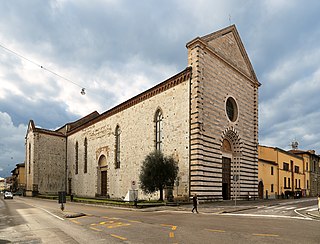
San Francesco is a Gothic-style, Roman Catholic church located on the piazza of the same name in Pistoia, region of Tuscany, Italy.
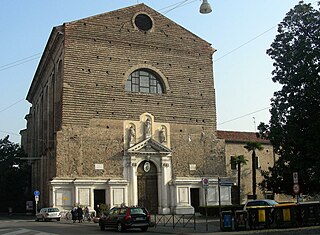
The Basilica del Carmine is a 16th-century Roman Catholic church located on piazza Francesco Petrarca in Padua, region of Veneto, Italy. It was made a minor basilica in 1960 by pope John XXIII
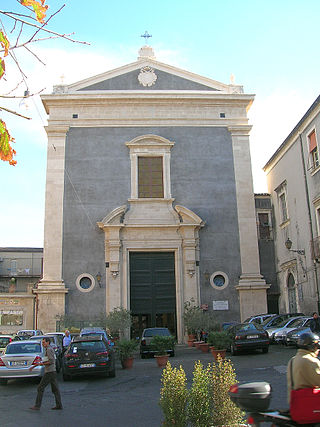
Sant’Agata la Vetere is a Roman Catholic church located in the piazza of the same name in Catania, Sicily, southern Italy. East of church and nearby, but facing in the other direction, are two other churches venerating St Agatha of Sicily: the church of Sant'Agata al Carcere and two blocks east on Piazza Stesicoro is Sant'Agata alla Fornace, now known San Biagio.

San Placido is a Roman Catholic church and former-Benedictine monastery located on the piazza of the same name in Catania, Sicily, southern Italy. The complex, two blocks east of the Catania Cathedral, spans a polygonal block encompassed by the Via Vittorio Emanuele II on the north, the via Landolina to the east, the via Museo Biscari on a south diagonal, and to the west the piazza San Placido and Via Porticello. Part of the convent is occupied by the Palazzo della Cultura, used for cultural activities and exhibitions. The Monastero di San Placido also serves presently as the Archivio di Stato di Catania.

Santa Agata al Carcere, sometimes called Santo Carcere or the Carcere church is a Roman Catholic church located on Piazza Santo Carcere #7, in the city of Catania, Sicily, southern Italy. It is one of three nearly adjacent churches venerating St Agatha of Sicily in this neighborhood, the other two being Sant'Agata alla Fornace and Sant'Agata la Vetere.
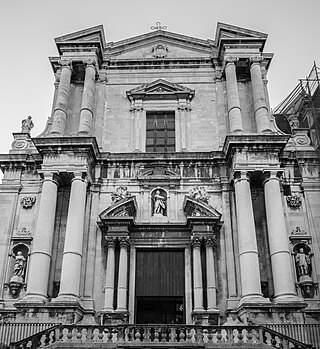
San Francesco Borgia is a Roman Catholic church located on Via Crociferi #7, adjacent to the former Collegio Gesuita, and parallel to San Benedetto, and about a block south on Crociferi of the church and convent of San Giuliano, in the city of Catania, region of Sicily, southern Italy. The church is mainly used for exhibits, but still holds much of the original Jesuit artwork.

Santa Rita in San'Agostino, sometimes just called Sant'Agostino, is a Roman Catholic parish church and sanctuary, located on Via Vittorio Emanuele II #318, in Catania, region of Sicily, southern Italy. The church was formerly attached to an Augustinian convent, and known as Sant'Agostino. But in the 20th century was dedicated as a sanctuary to Santa Rita of Cascia.

San Domenico, also called Santa Maria la Grande is a Roman Catholic church and active convent located on piazza San Domenico in the quartiere di Santa Maria la Grande, in Catania, region of Sicily, Italy. The church stands about two blocks north of the church of Sant'Agata la Vetere on via Santa Maddalena. The neoclassical-style, late 17th-century church houses a few prominent altarpieces that survived the 1693 catastrophe in Catania.
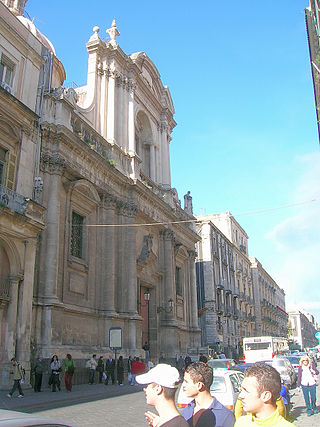
San Michele Arcangelo ai Minoriti is a Roman Catholic parish church and attached monastery in the city center of Catania, region of Sicily, Italy. The former monastery, to the left of the facade, now houses shops on the ground-floor, and above are the offices of the Provincial government and the Prefettura or Prefecture.

Madonna dei Rimedi is a Baroque-style, Roman Catholic Sanctuary-church, established and still affiliated with the Discalced Carmelite order, located on Piazza Indipendenza # 9, in Palermo, region of Sicily, Italy.